Endometriosis is a common but often underdiagnosed condition due to its varied appearance.
Endometriosis is defined by the presence of endometrial-like mucosa outside the normal anatomical boundaries, i.e. outside the cavum uteri. Affecting about 6-10% of women of reproductive age, endometriosis must be considered a relatively common disease, but often undiagnosed for a long time due to its highly variable manifestation. The latency period from the first symptoms to the diagnosis in this country takes 6-9 years, a long time during which the affected women usually visit five different doctors and medical institutions (not infrequently also psychiatrists). This fact already suggests that diagnostics can cause major problems under certain circumstances.
Unexplained pathogenesis
The predilection sites of ectopic mucosal islands represent the peritoneum of the pelvis, the ovaries, and the rectovaginal septum, although endometriosis has also been described in virtually all other anatomic locations. A familial cluster is observed. So far, however, no endometriosis-specific mutations or epigenetic changes have been discovered that could adequately explain this observation.
The pathogenesis of the disease is still not fully understood, which makes causal therapy very difficult or impossible. Retrograde menstruation, however, seems to be an indispensable prerequisite, although it alone cannot explain the clinical picture, since almost all women with open tubes during menstruation show such retrograde menstruation. Accordingly, for endometriosis to develop, other additional factors must play a role. Somehow, the carried-over endometrial cells must manage to proliferate in a foreign environment, escape the immune system and connect to the vascular system.
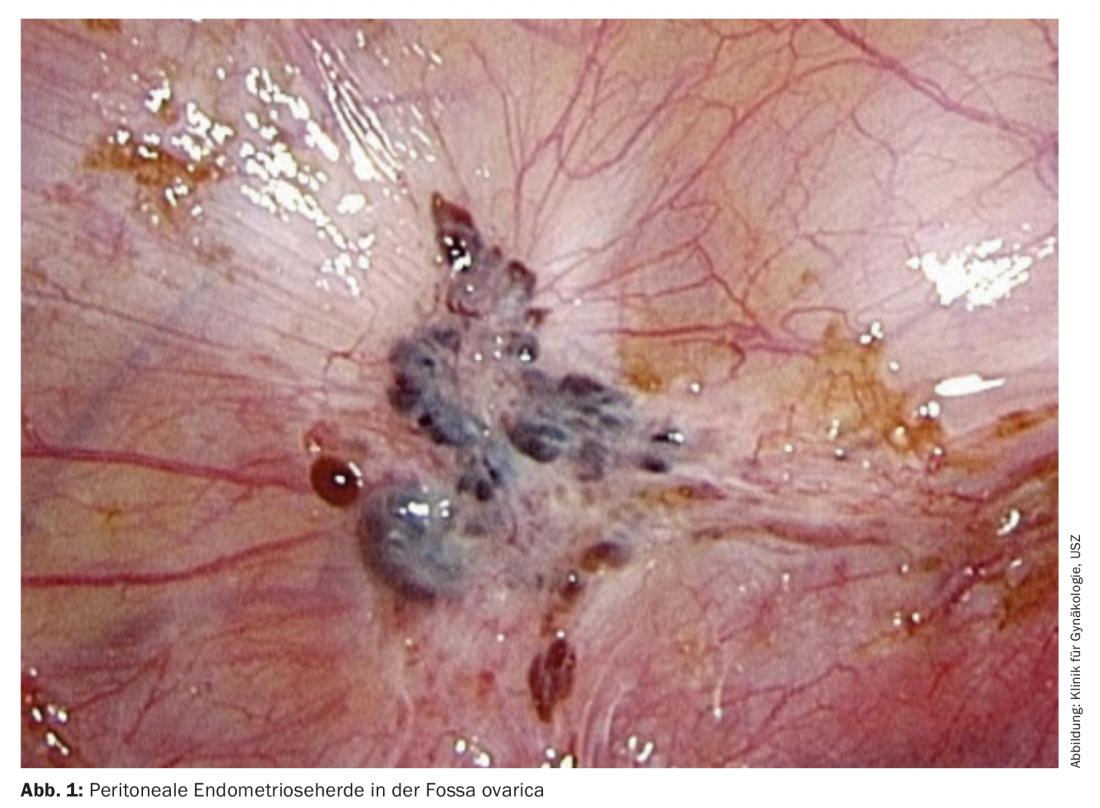
Essentially, three different forms of endometriosis are described, but all of them are defined by the presence of epithelial and stromal endometrial cells at ectopic sites. The different forms often occur in combination. The first form is peritoneal endometriosis, which is manifested by nodules, some of which are only the size of a pinhead, on the peritoneum but do not penetrate it to any great extent (Fig. 1) . The second form comprises ovarian endometriosis, which manifests itself by endometriosis cysts, so-called “chocolate cysts”, on the ovaries. The third and most severe form is deep infiltrating endometriosis. In this case, anatomical boundaries are no longer observed, and there is migration through the peritoneum and infiltration into surrounding organs, primarily the rectosigmoid and the bladder (Figs. 2 and 3). In this form, marked accompanying fibrosis of the tissue is also frequently seen. However, as already indicated, endometriosis is also found in quite unusual locations, such as the lungs, which underpins the potentially infiltrative nature of the disease.
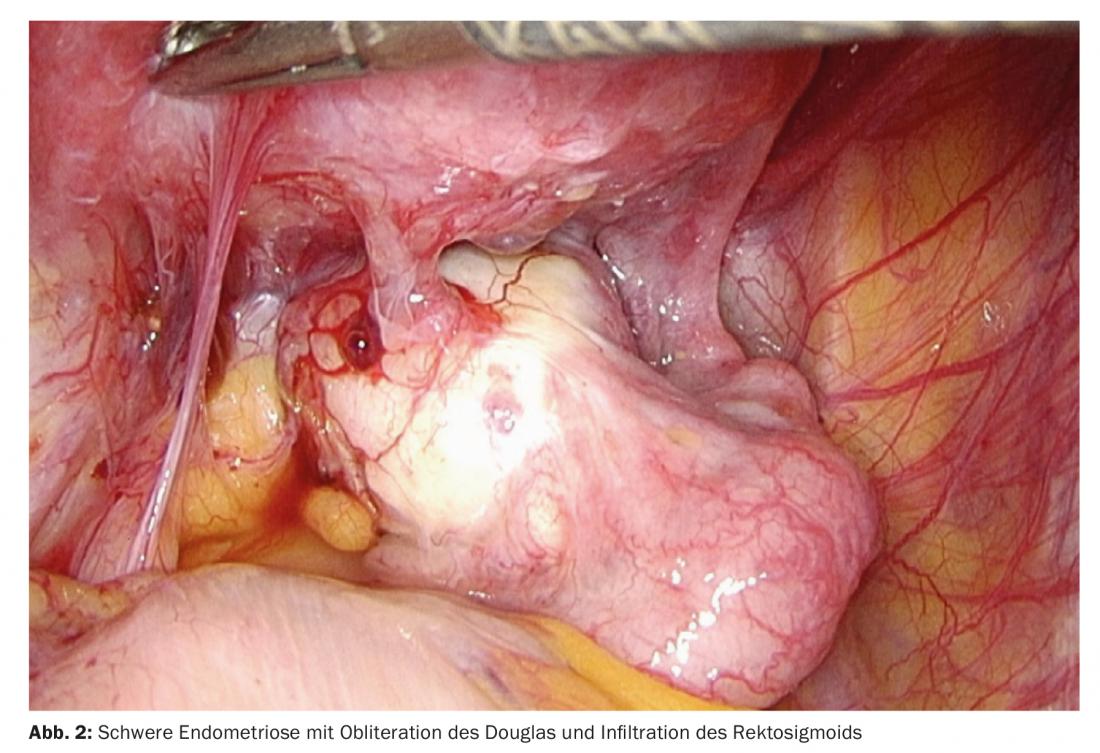
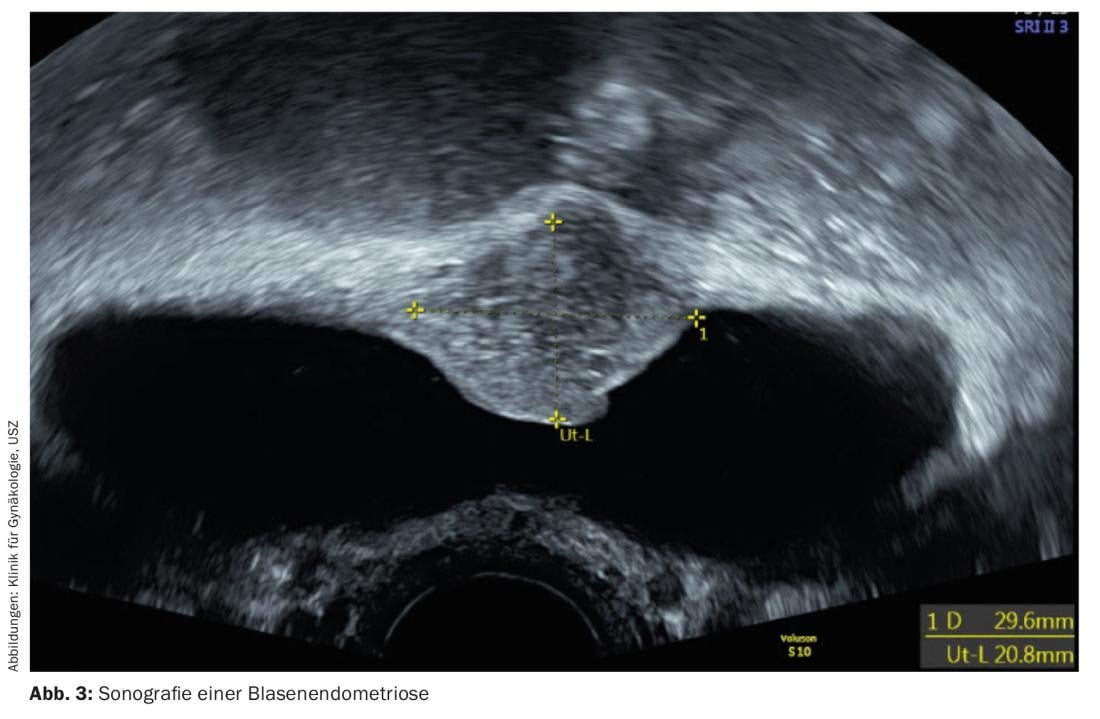
Broad symptomatology
Endometriosis is typically a pain disorder. Cardinal symptoms include dysmenorrhea. However, long-lasting endometriosis can change the pain pattern and turn into chronic lower abdominal pain. Thus, cycle-independent pain is not a criterion for exclusion of endometriosis. Other common symptoms in endometriosis patients include dyschezia, dysuria, and dyspareunia. Patients also repeatedly complain of bloating and stool irregularities perimenstrually.
Endometriosis nodes on the diaphragm can typically cause shoulder pain. Sometimes endometriosis lesions are found in the area of former surgical scars, e.g. acetabular styloid aparotomies after sectio or umbilical after laparoscopies. Here, cycle-dependent pain, swelling and bloody umbilical secretions may occur. A good half of endometriosis patients also complain of fatigue, a symptom that is rarely mentioned in connection with endometriosis but is nevertheless frequently observed.
Although endometriosis is primarily a pain disorder, this represents only half the truth. Endometriosis may also be associated with infertility. Thus, an above-average number of endometriosis patients are found in specialized fertility consultations. However, it is not completely clear how sterility occurs. Of course, partly a mechanical factor, due to adhesions that have arisen due to the chronic inflammatory character of the disease, can be understood as causative. Very likely, however, humoral factors are also responsible, which unfavorably alter the receptivity of the endometrium. Also, the first epigenetic changes have already been described, which may also have a detrimental effect on embryo implantation. Mild endometriosis, as is present in superficial lesions, is associated with a severe degree of inflammatory disturbance, possibly leading to defective folliculogenesis, fertilization, and/or implantation, in addition to being considered an increased risk of miscarriage. An increased abortion rate in endometriosis patients has therefore been described.
Difficult diagnosis
The long latency periods from initial symptoms to diagnosis suggest that diagnosis can be problematic. The main difficulty is that the lesions are often very small and thus escape any imaging (Fig. 1). Relatively simple is the diagnosis of endometriosis cysts, which can be well visualized by transvaginal sonography (Fig. 4) and show the typical picture of echogenic cysts. So-called “kissing ovaries”, i.e. bilateral endometriosis cysts touching each other, must in many cases be understood as a sign of an additionally existing, deeply infiltrating endometriosis. The skilled examiner can also sonographically visualize deeply infiltrating endometriosis nodes in the rectovaginal septum and rectosigmoid. A sonographic check of the kidneys to exclude endometriosis-related ureteral stenosis is also part of the examination. If deep infiltrating endometriosis is suspected, MRI may be considered as an additional diagnostic tool. MRI is also of great benefit in the diagnosis of related adenomyosis. MRI findings regarding deep infiltrating endometriosis correlate relatively well with intraoperative findings. Blood parameters such as the tumor marker CA 125 are of no use. Although this marker is regularly elevated in endometriosis, it cannot be used meaningfully for diagnosis or as a therapy control and should therefore not be routinely determined. If all imaging options are inconclusive but the history is highly suspicious, laparoscopy with direct visualization of the endometrosis nodes must be considered to confirm the diagnosis.
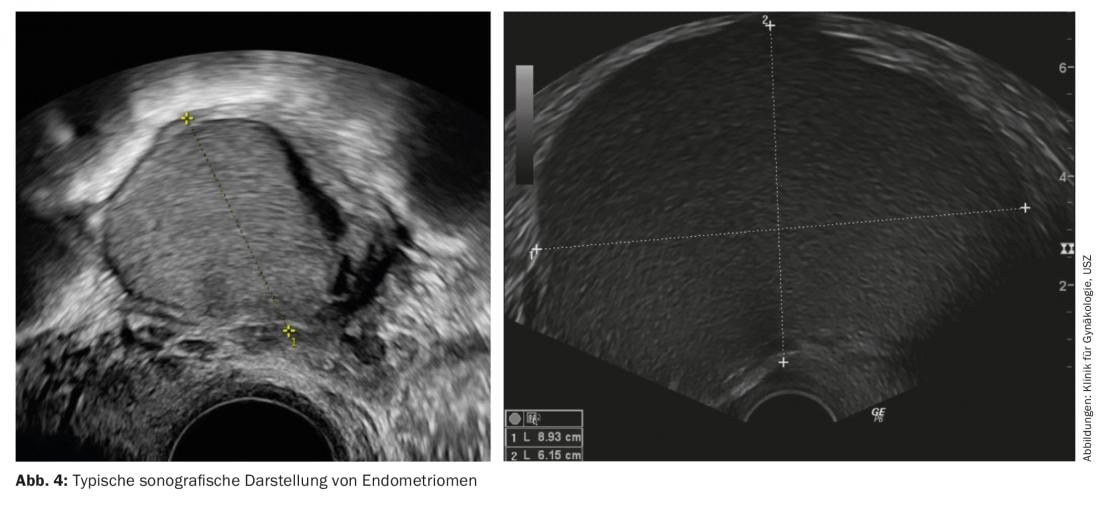
Therapeutic options
Surgical and drug therapy options are available, and the two methods are often combined. In women with suspected or confirmed endometriosis without clinical sonographic signs of stenosis, endocrine therapy may be recommended primarily to reduce pain (Fig. 5). Such therapies can be achieved, for example, with monophasic pills or progestin-only preparations. Randomized controlled trials show a significant benefit in the reduction of dysmenorrhea with ovulation inhibitors in direct comparison to placebo. Ovulation inhibitors may also minimize the likelihood of endometrioma recurrence after surgical repair. It is important to understand that the administration of ovulation inhibitors does not cure endometriosis and that in many cases the disease can be expected to flare up again after discontinuation of the preparations.
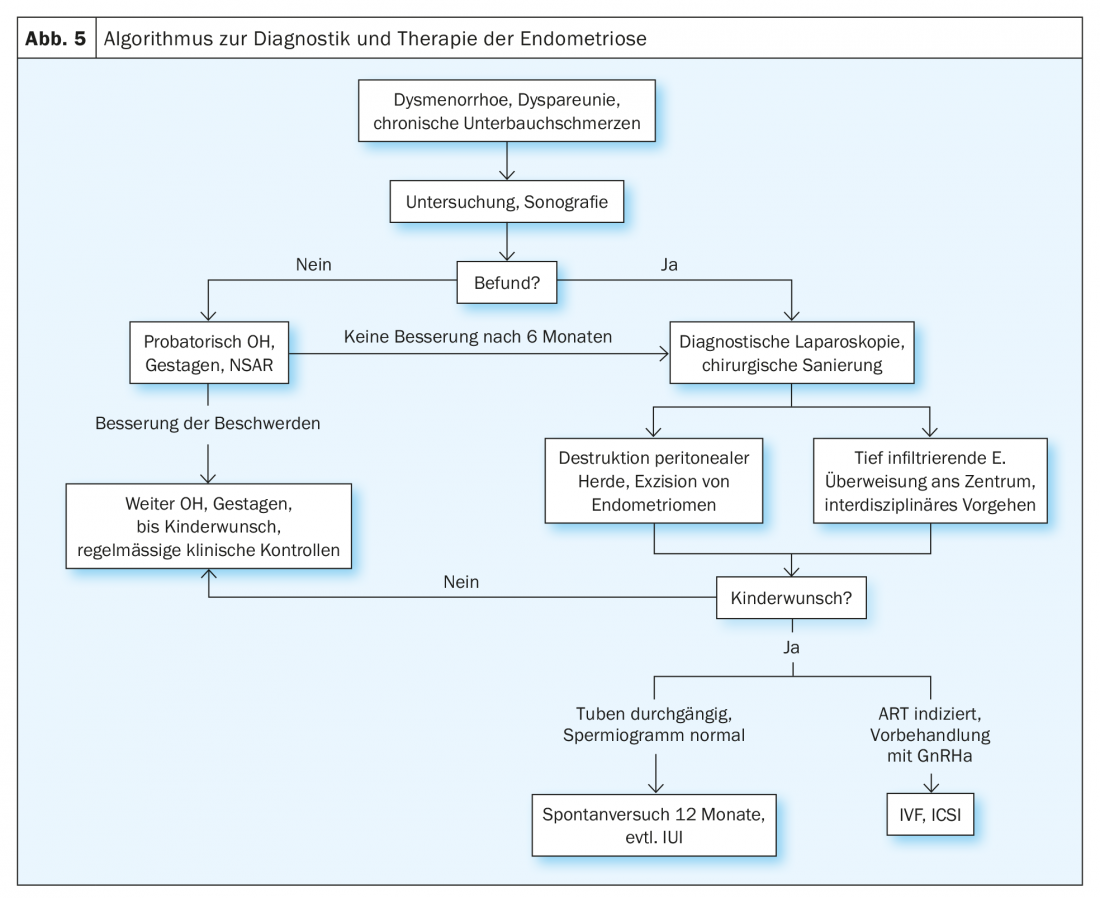
When monophasic pills are administered, it is recommended to administer them in a long-term cycle, i.e. without a pill break. Today, progestins are considered by many experts to be the first-choice treatment option. One advantage of progestins is that they can be administered in different forms. Oral administration, subdermal implants, injections and intrauterine coils are conceivable, so that adequate therapy management can be selected for the majority of patients. Good data are available on Dienogest (Visanne®). With equal efficacy compared with GnRH antagonists (the former gold standard), the administration of 2 mg dienogest demonstrates a substantially lower incidence of “hot flushes” and only a minimal effect on bone density. Since no significant glucocorticoid, mineral corticoid and androgenic activity is observed and serum estradiol levels are only moderately reduced, Dienogest gains importance especially with regard to long-term treatment.
Very often, surgery becomes necessary in the course of endometriosis. The definitive diagnosis is already made by means of laparoscopy. In addition to diagnostic purposes, laparoscopic examination is also indicated in cases of persistent pain under drug therapy, objectifiable progressive findings (e.g. nodules in the rectovaginal septum, growing endometrioma), organ changes caused by endometriosis (caution: ureteral stenosis) and finally also in cases of unclear ovarian findings and not yet histologically verified diagnosis of endometriosis. If severe deep infiltrating endometriosis is encountered unexpectedly during diagnostic procedures, it is often recommended that the surgery be aborted and a two-stage definitive rehabilitation of the endometriosis be planned. In these cases, patients can be better prepared for the operation and more adequately informed about possible extensions of the procedure. Ideally, severe endometriosis cases are operated on in a specialized center by a multidisciplinary team.
Surgically very challenging is deep infiltrating endometriosis. In many cases, surgical remediation can significantly reduce pain in women with deep infiltrating endometriosis – with a clear gain in quality of life for the affected patients. Nevertheless, it is important to note the substantial intraoperative and postoperative complication rates.
Take-Home Messages
- Endometriosis is a common but significantly underdiagnosed condition.
- Despite a very different clinical presentation, one should consider the possibility that it could also be endometriosis.
- If endometriosis is suspected without signs of stenosis, the primary probationary drug trial is warranted.
- Progestogens represent the first-choice drug therapy approach.
- Endometriosis patients require long-term therapy planning (recurrence prophylaxis, desire for children, etc.).
Further reading:
- Zondervan KT, et al: Endometriosis. Nat Rev Dis Primers 2018; 4(1): 9. Diagnosis and management of endometriosis: summary of NICE guidance.
- Kuznetsov L, et al: Diagnosis and management of endometriosis: summary of NICE guidance. BMJ 2017; 358: j3935.
- Imesch P, Fink D: Surgery of infiltrative growing endometriosis. Schw Zeitschr f Gynäkol 2018; 1: 6-9.
- Imesch P, Fink D: Endometriosis update 2016. Praxis 2016; 105(5): 253-258.
- Satisfaction with medical support in women with endometriosis.
- Lukas I, et al: Satisfaction with medical support in women with endometriosis. PLoS One 2018; 13(11): e0208023.
HAUSARZT PRAXIS 2019; 14(4): 21-25











